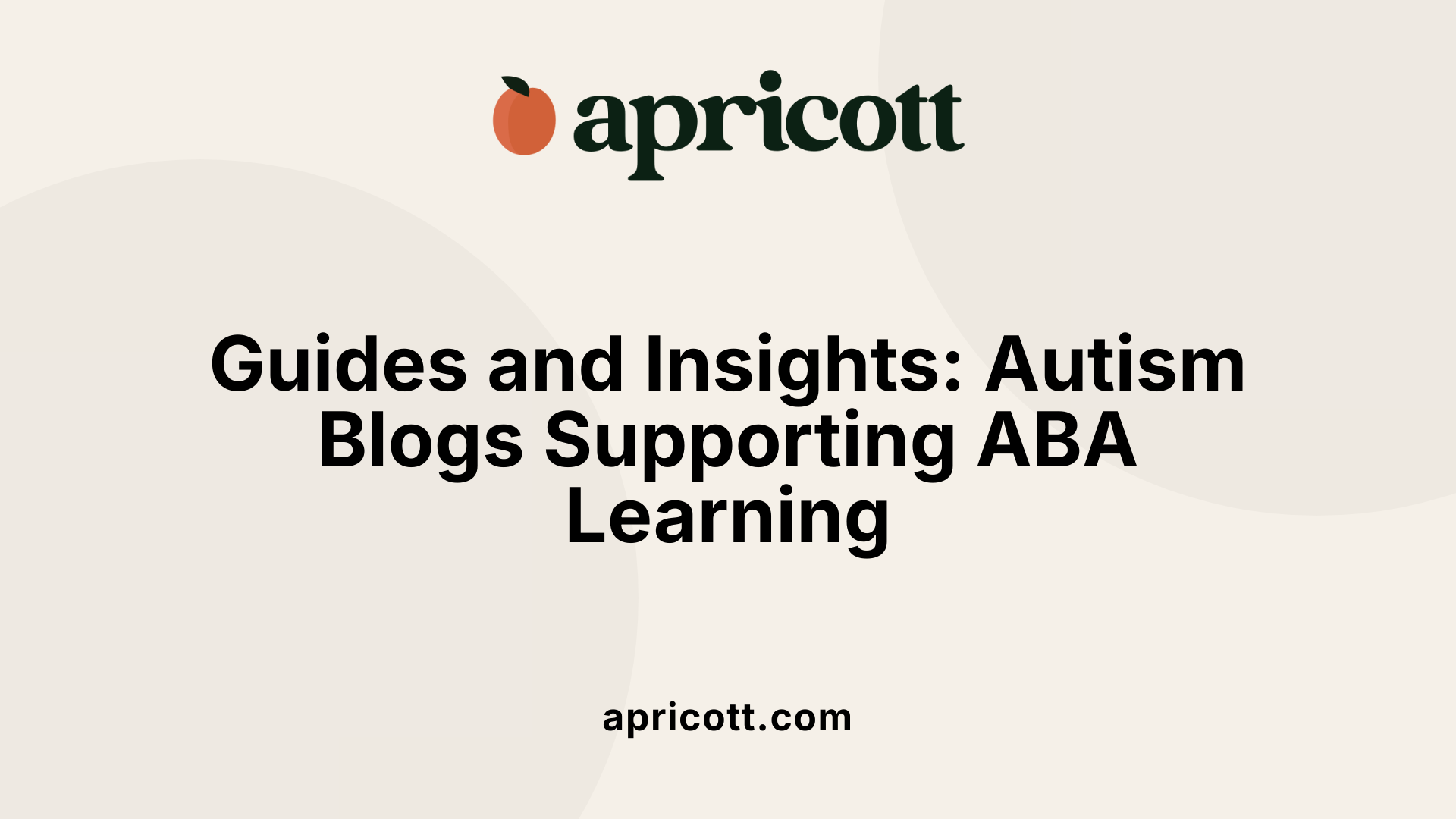December 2, 2025
Exploring Insightful Autism Blogs: Understanding ABA Therapy and Its Role
Autism blogs offer a rich source of information, support, and firsthand perspectives for parents, professionals, and individuals on the spectrum. Among the many topics these blogs address, Applied Behavior Analysis (ABA) therapy stands out as a widely discussed and researched intervention. Through expert insights, personal stories, and educational resources, autism blogs help demystify ABA therapy, providing a clearer understanding of its techniques, providers, and impact.

Applied Behavior Analysis (ABA) therapy is a science-based approach focused on understanding and modifying behavior. It utilizes principles from behavioral science to encourage helpful behaviors and reduce harmful ones.
ABA aims to increase essential skills such as communication, social interactions, self-care, and academic abilities. It also works to decrease behaviors that may interfere with learning or daily functioning.
A central technique in ABA is positive reinforcement, where desired behaviors are rewarded to encourage their repetition. The ABA framework uses the Antecedent-Behavior-Consequence (ABC) model to analyze behavior by identifying what triggers it and what follows, enabling targeted interventions.
ABA therapy is highly flexible and can be delivered in various environments including the home, school, or community. This adaptability ensures it can fit each individual's lifestyle and needs.
Programs are carefully tailored to the unique requirements of each person. They are designed and supervised by certified professionals known as board-certified behavior analysts (BCBAs) and implemented by trained therapists.
Extensive research, including over 20 studies, supports intensive ABA's effectiveness in improving intellectual functioning, language, daily living, and social skills for children with autism. These benefits enable greater independence and quality of life.
In summary, ABA therapy offers structured, evidence-based interventions that foster positive behavioral changes and skill development, helping individuals with autism engage more fully in their communities and reach their potential.

ABA therapy is delivered by a team of professionals with specialized training in behavior analysis and therapy. The primary providers include Board Certified Behavior Analysts (BCBAs), Behavior Analyst Assistants (BCaBAs), and Registered Behavior Technicians (RBTs). Each role has specific educational and certification requirements to ensure quality care.
BCBAs are highly trained professionals who design and oversee ABA programs. They typically hold graduate degrees in psychology, education, or related fields, and must complete rigorous coursework along with supervised practical experience. After meeting these criteria, they earn the BCBA certification by passing a comprehensive exam. BCBAs create individualized treatment plans tailored to each client's needs and monitor progress to make necessary adjustments.
RBTs and therapists work directly with clients to implement ABA strategies as outlined by BCBAs. RBTs usually hold a high school diploma or higher and complete a 40-hour training program along with competency assessments. They receive ongoing supervision to maintain skills and adhere to ethical standards. Therapists may have degrees in fields such as social work, education, or counseling, with additional ABA training to ensure effective delivery of interventions.
Providers generally have backgrounds in psychology, special education, counseling, or similar disciplines from accredited colleges. Certification through the Behavior Analyst Certification Board (BACB) or equivalent bodies confirms that practitioners meet established professional standards.
In certain states like Pennsylvania, ABA providers operate under agency licensure such as the Intensive Behavioral Health Services (IBHS) agency licensure. This licensure requires agencies to meet organizational standards, undergo state evaluations, and maintain compliance with regulatory guidelines, all of which help protect clients and uphold service quality.
Having properly trained and credentialed professionals is crucial to delivering effective ABA therapy. A foundation in evidence-based practice, continuous supervision, and adherence to ethical guidelines enables providers to deliver personalized interventions that improve communication, social skills, and behavior management in individuals with autism.
Overall, the qualifications and licensing requirements ensure that ABA services are provided by knowledgeable and skilled professionals committed to advancing the well-being of those they serve.

Applied Behavior Analysis (ABA) therapy uses a range of proven techniques to target behavioral challenges effectively. One primary method is positive reinforcement, which rewards desired behaviors to encourage their repetition. For instance, when a child successfully completes a task, immediate praise or a preferred item may be given to strengthen that behavior.
Another important technique is task analysis, where complex skills are broken down into smaller, achievable steps. This simplification helps learners gradually master new activities.
Discrete Trial Training (DTT) offers a structured approach with repeated teaching trials that include a prompt, a learner's response, and a consequence, often positive reinforcement. This method helps teach specific skills in a controlled, predictable manner.
In contrast, Natural Environment Teaching (NET) focuses on integrating learning into everyday situations, promoting skill generalization in environments such as home or community settings.
To tailor interventions precisely, ABA therapists conduct a Functional Behavior Assessment (FBA). FBA identifies the reasons behind behaviors by analyzing triggers and consequences, enabling customized behavior plans.
Additional tools include modeling (demonstrating behaviors), prompting (guiding responses), fading (gradually reducing assistance), and extinction (eliminating reinforcement of undesirable behavior) to help increase useful skills and decrease harmful behaviors.
By combining these techniques, professionals develop individualized ABA programs that enhance communication, social engagement, and daily living skills, while effectively reducing problematic behaviors.

ABA therapy heavily relies on systematic data collection to track progress. Therapists and behavior analysts observe and record behaviors through detailed notes and structured tools, capturing how frequently or how long specific behaviors occur. This precise tracking is fundamental to understanding whether the interventions are working.
Each ABA program is tailored to the individual, with specific, measurable goals set around communication, social skills, adaptive behaviors, or other targeted areas. These personalized objectives ensure therapy focuses on meaningful growth for the individual.
Behavior is monitored using clear operational definitions, making it easier to consistently identify when behaviors happen. Data collection often involves measuring not just if a behavior occurs, but also the context and consequences, applying the ABA A-B-C model to understand the full behavioral cycle.
Common metrics include frequency (how often a behavior occurs) and duration (how long it lasts). These quantitative measurements provide objective indicators of progress or setbacks, making it easier to evaluate therapy impact.
By charting progress over days or weeks, therapists can visually assess if goals are being met. If data indicates limited improvement, intervention strategies are revised, allowing for a flexible and responsive approach.
More than 20 peer-reviewed studies show that intensive ABA therapy improves intellectual, language, social, and daily living skills in children with autism. This robust evidence base validates the data-driven methods used in clinical practice to measure effectiveness.
These combined assessment strategies ensure ABA therapy remains a scientifically grounded, individualized, and adaptable treatment approach.

Applied Behavior Analysis (ABA) therapy, while widely recognized for its effectiveness, faces several challenges and criticisms. One significant concern is its intensity and time commitment; ABA often requires 10 to 20 hours of therapy per week. This rigorous schedule can place a considerable strain on both the child and their family, sometimes leading to burnout or logistical difficulties.
Critics also point to the emotional impact of ABA. Some argue that it may focus too heavily on reducing or eliminating behaviors that are part of an individual's authentic self-expression, such as stimming in autistic individuals. This suppression can cause emotional distress and hinder the acceptance of neurodiverse traits.
Historically, ABA was associated with the use of aversive techniques to modify behavior. Although modern ABA practices emphasize positive reinforcement and the avoidance of punishment, the legacy of these earlier methods still colors public perception and fuels some criticism.
Additionally, there is ongoing debate in the autism community regarding neurodiversity and masking. Some advocates suggest that ABA encourages masking—where autistic individuals hide their natural behaviors to fit societal norms—potentially leading to anxiety, depression, or burnout later in life.
These concerns highlight the importance of individualized, ethical, and compassionate approaches in ABA therapy. When tailored carefully by board-certified behavior analysts and therapists, and when respecting the identity and well-being of each person, ABA can mitigate these challenges while helping individuals develop communication, social, and daily living skills effectively.

Autism blogs serve as vital platforms for educating families, caregivers, and professionals about Applied Behavior Analysis (ABA) therapy. They break down complex concepts, explain therapy techniques, and share the latest research in accessible language. These blogs help demystify ABA, providing dependable information that supports informed decision-making.
Autism blogs offer an extensive range of content formats. Readers can find expert insights from board-certified behavior analysts, practical tips for parents navigating ABA, engaging videos demonstrating strategies, and detailed articles covering therapy progress and challenges. This variety ensures that different learning preferences are accommodated, simplifying the journey through ABA therapy.
Yes, these platforms often address diverse topics linked to ABA and autism support. This includes exploring how diversity impacts therapy, managing anxiety—a common concern among autistic individuals—and sharing best practices that align with evolving ABA methodologies. By addressing varied themes, blogs offer comprehensive support beyond just therapy techniques.
A prime example is Trellis, a respected resource hub offering tools, expert insights, and community-driven content. Trellis equips parents and professionals with practical advice and educational materials crafted for real-world challenges encountered in ABA therapy. Their commitment to inclusivity and evidence-based information makes them a trustworthy ally.
Indeed, podcasts such as 'All Autism Talk' enrich the community experience by blending expert interviews, personal stories, and conversations with individuals on the autism spectrum. These audio formats provide unique perspectives and continue education in an engaging and accessible way, fostering connection and deeper understanding.
Autism blogs do more than inform—they build communities and promote continuous learning. They offer a steady stream of updated content, answering emerging questions and sharing innovations in ABA therapy. For families and professionals alike, these blogs become trusted companions on the journey toward effective and compassionate autism support.
Autism blogs serve as invaluable platforms that blend research, professional expertise, and community experiences related to Applied Behavior Analysis therapy. They offer accessible, up-to-date information empowering families and professionals to make informed decisions and advocate effectively. By exploring these blogs, readers gain deeper insights into ABA techniques, providers' qualifications, measures of success, and the thoughtful consideration of challenges and criticisms. Ultimately, these online resources foster understanding and acceptance, supporting the journey toward better outcomes and enriched lives for individuals with autism.